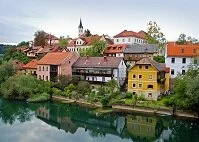Architecture of Slovenia

Breg Street in Ljubljana
The architecture in Slovenia is fairly limited, but the capital city of Ljubljana is a center for Baroque and Art Nouveau. Besides this, the architectural highlights are not significantly unique or impressive structures as there are few buildings of note. Among these though, Bled Castle was founded in the 1000s and has aspects of Romanesque to Renaissance architecture. Also in Bled is the Pilgrimage Church of the Assumption of Mary (1400s), which is again nothing spectacular outside the setting itself.

Novo Mesto
Ljubljana grew under Austrian rule in the 1500s after an earthquake destroyed much of the city. This re-building was modeled after their neighbor and occupying country at the time, Austria and some of their cities. The Church of the Annunciation (1646-1660) takes on the Baroque style. The next major influence to hit Slovenia arrived in the late 1800s when another earthquake destroyed much of the city once again. This time the city was re-built in various styles, including neo-Classical, Vienna Secession, and Art Nouveau. The most well-known piece from this time period is the Triple Bridge (1842; second and third bridges were added in 1932), which leads up to the Church of the Annunciation.